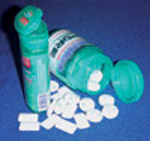|

According to the American Dental Association over 660 million tonnes of chewing gum is manufactured annually. The average chewer consumes at least 300 wads a year. Germany’s Statista Research Department forecasts global chewing gum sales to reach 48.68 USD in 2025.
Chewing gums are available in myriad unique shapes, sizes and types such as bubblegum, gum balls, pellets, pops, sticks and ribbons. Many are sugar-free, few medicated, and some are energy gums which contain added ingredients such as nicotine, caffeine and ginseng. Claimed to be biodegradable, organic and all-natural gums, many are now marketed worldwide in just about all flavours and colours.
It is said that chewing gum improves memory and enhances cognitive powers, reduces stress, aids alertness and concentration, helps to manage weight, improves oral/dental health and digestion. If added to chewing gum, fluoride strengthens tooth enamel; and p-chlorbenzyl-4-methylbenzylpiperazine prevents travel sickness. It is also said that chewing gum promotes weight gain and stimulates saliva which sends a message to the pancreas that food is coming and insulin should be released which could set the chewer up for the onset of adult diabetes.
Few ask what chewing gums contain – just like other packaged foods, some may turn out to be non-veg. They consist of a gum base, filler, softener, sweetener, flavouring, and preservative.
Gum bases: Mainly considered as mouth fresheners, people have been chewing gum for over 5,000 years! Different tree resins or gums like mastic, spruce, sorva and jelutong, as also paraffin or candelilla wax are known, but in the 1800s chicle latex or sap for chewing gum from chicle-sapodilla, tropical evergreen trees began to be widely used because of its smoother and softer texture.
Today, chewing gum is also be made from synthetic rubber. In fact, manufacturers prefer it because it is cheaper and easily available in comparison to latex.
Some chewing gum bases may contain about 15% latex, the rest being synthetic rubber such as polyisobutylene, butadiene-styrene, polyethylene and polyvinyl acetate (all mineral/petroleum origin). Bubblegum base is usually a mixture of starches and polymers made in a lab. These polymers are insoluble in water and that’s why it is so hard to clean surfaces on to which they are stuck. (Believe it or not in 2014, Queen Elizabeth II advertised for a cleaner to remove chewing gum off the furniture etc. at her official residence!)
Preparation requires that the raw gum base material be melted down in a sterilized steam cooker and pumped into a high-powered centrifuge to rid it of undesirable dirt and bark. Other ingredients are then added in varying secret proportions.
Fillers: Chewing gum fillers are calcium carbonate (mineral/animal origin) and corn starch.
Softeners: Refined vegetable oil or glycerine (animal/vegetable origin) is added to keep the chewing gum fresh, soft and moist.
Sweeteners: Artificial (and said to be harmful) sweeteners like xylitol and mannitol (both plant), sorbitol, saccharine, aspartame and sucralose (all vegan) in place of sugar/corn syrup/beet juice could be used.
Flavourings: Mint flavouring is from aromatic plant oils. Most fruit flavours are artificial, e.g. apple from ethyl acetate and cherry from benzaldehyde.
Preservatives: The preservative/antioxidant used in chewing gum could be BHT/butylated hydroxy toluene which is vegan or BHA/butylated hydroxyanisole which contains hydroquinone prepared from Bombardier beetles.
Disposal: Chewing gum is not biodegradable. Its disposal is a big issue from the hygienic point of view. This is the reason why it is banned on certain campuses. Singapore banned it in 1993 saying it could not be disposed off properly. Moreover, it should not be thrown away even in the garbage because animals and birds may consume it with disastrous effects – it may not kill, but till it is passed out it could cause problems. A few birds that have had chewing gum stuck in their beaks or throat have unfortunately starved to death.
Advertisements cowed down: Chewing gum ads in India mainly focus on making teeth white and avoiding tooth decay, e.g. Happydent, Center Fresh, and Orbit White. A 2005 Orbit ad showed a cow chewing with the tagline “It’s working”. The ad for Chlor-mint also showed cows being fed the chewing gum and then being ridiculously milked for ice cream. Even a disclaimer that this was a “symbolic representation” didn’t stop the ire of a political party. However, an ad for Mentos chewing gum has got away with a disclaimer which reads “Donkeys are not intended to be working animals”. |